Boone REMC’s Participate in our satisfaction survey

to a

Boone REMC’s Participate in our satisfaction survey

to a
Hoosiers embrace — and brace for — total eclipse


I don’t want to be a one-trick pony and only write about sports, but March feels like a time for basketball reflection.
Like most Hoosier kids, my love of basketball began by playing pick-up games with an old hoop in my grandparents’ driveway. I cannot say I am the most athletically gifted person, but as a kid, I could hang in there during a game of HORSE.
What accelerated my love of basketball was Friday nights packed into my high school gym with many of my fellow residents of Ellettsville, Indiana. Edgewood High School was pretty good my junior and senior years, going undefeated my junior year. We had high hopes for a state championship during that time but unfortunately ran into the Zeller brothers in Washington.
It’s hard to sit through the energy of an Indiana high school basketball game and not feel at least a little invested. Some of my favorite high school memories are cheering courtside in the student section during rivalry games against Spencer’s Owen Valley High School. Those games felt personal and were a matter of town pride.
When I got to IU, my love of basketball only grew. Assembly Hall is a magical place where you can feel the weight of so many historic basketball moments. My childhood friend, Stephen, and I had season tickets every year, and we rarely missed a game. We were side-by-side when IU beat Kentucky in 2011, and that memory will stay with us forever.
Many of our out-of-state college friends didn’t understand why we were so dedicated to the outcome of the basketball season, but Stephen and I grew up attending impassioned games in standing-room-only gyms that required the fire marshal to turn people away at the door. Those are memories that stay with you, too. As they say, in 49 states, it’s just basketball, but this is Indiana.

 Britt Davis Editor
bdavis@indianaec.org
Britt Davis Editor
bdavis@indianaec.org
On the menu: July: No-bake recipes, deadline May 1. If we publish your recipe on our food pages, we’ll send you a $10 gift card.
Giveaway: 2024 Total Eclipse Survival Kit from MoonPie. Visit indianaconnection.org/talk-to-us/contests or send your contact information to the address below. The deadline to enter is March 30.
you.
Three ways to contact us: To send us recipes, photos, letters and entries for gift drawings, please use the forms on our website indianaconnection.org; email info@indianaconnection.org; or send to Indiana Connection, 8888 Keystone Crossing, Suite 1600, Indianapolis, IN 46240-4606.
VOLUME 73 • NUMBER 9
ISSN 0745-4651 • USPS 262-340
Published monthly by Indiana Electric Cooperatives
Indiana Connection is for and about members of Indiana’s locally-owned, not-for-profit electric cooperatives. It helps consumers use electricity safely and efficiently; understand energy issues; connect with their co-op; and celebrate life in Indiana. Over 311,000 residents and businesses receive the magazine as part of their electric co-op membership. The average printed and mailed cost per issue is 54 cents.
CONTACT US:
8888 Keystone Crossing, Suite 1600 Indianapolis, IN 46240-4606 317-487-2220
info@indianaconnection.org IndianaConnection.org
INDIANA ELECTRIC
COOPERATIVES OFFICERS:
Steve McMichael President
Dr. Richard Leeper Vice President
Jamey Marcum Secretary/Treasurer
John Cassady CEO
EDITORIAL STAFF:
Britt Davis Editor
Richard George Biever Senior Editor
Holly Huffman Communication Support Specialist
Lauren Carman Communication Manager
Kiley Lipps Graphic Designer
Ashley Curry Production and Design Coordinator
Amber Knight Creative Manager
Mandy Barth Vice President of Communication
ADVERTISING:
American MainStreet Publications
Cheryl Solomon, local ad representative; 512-441-5200; amp.coop
Crosshair Media 502-216-8537; crosshairmedia.net
Paid advertisements are not endorsements by any electric cooperative or this publication.
UNSOLICITED MATERIAL:
Indiana Connection does not use unsolicited freelance manuscripts or photographs and assumes no responsibility for the safekeeping or return of unsolicited material.
SUBSCRIPTIONS:
$12 for individuals not subscribing through participating REMCs/RECs.
CHANGE OF ADDRESS:
If you receive Indiana Connection through your electric co-op membership, report address changes to your local co-op.
POSTAGE:
Periodicals postage paid at Indianapolis, Indiana, and at additional mailing offices.
POSTMASTER:
Send change of address to: Indiana Connection, 8888 Keystone Crossing, Suite 1600, Indianapolis, IN 46240-4606. Include key number.
No portion of Indiana Connection may be reproduced without permission of the editor.




13 INSIGHTS
Learn more about the
16
18 FOOD
These MoonPie recipes will get you in the mood for the historic eclipse
20 COVER STORY
Hoosiers embrace — and brace for — eclipse fever
26 PROFILE
Senior editor Richard Biever reflects on a 35-year body of

28 HOOSIER ENERGY/ WABASH VALLEY NEWS
29 PETS
Find your perfect dog with these tips (NOT IN ALL EDITIONS)
30 DIY
Tackle messy home projects this spring (NOT IN ALL EDITIONS)
29 county pets FOLLOW
On April 8, over half of Indiana will experience a total solar eclipse for the first time in 155 years. The “zone of totality” is centered on a line running northeast from Vincennes through Bloomington, New Castle, and Union City. The zone extends about 50 miles to either side. Totality will arrive just after 3 p.m. Eastern Time.
CONTACT US
800-897-7362
WEBSITE
www.bremc.com
contactus@bremc.com
OFFICE HOURS
7:30 a.m.-4:30 p.m.
STREET ADDRESS
1207 Indianapolis Ave. Lebanon, IN 46052
MAILING ADDRESS
P.O. Box 563 Lebanon, IN 46052
POWER OUTAGES
To report a power outage, visit bremc.com/report-an-outage
BOARD OF DIRECTORS
District 1 — W. Daniel Lawson
District 2 — Thomas E. Dull
District 3 — Mark Gruninger
District 4 — G. Tom Taylor
District 5 — Jon Stevens
District 6 — Alan D. Cragun
District 7 — Bruce Guernsey
District 8 — Mark Starkey
District 9 — Noel R. Kendall
READ ONLINE!
Check out our flipbook at bremc.com/ indiana-connection-magazine
Like us on Facebook facebook.com/ BooneREMC
Follow us on X, formerly known as Twitter twitter.com/ BooneREMC
Visit our YouTube channel youtube.com/ BooneREMC
Follow us on Instagram instagram.com/ BooneREMC
Our 2024 Annual Meeting is right around the corner!
In late March, all Boone REMC members will be mailed an official notice that includes a director election ballot and registration card. Members who participate in the director election will receive a bill credit.
One option for returning your ballot is a drive-thru event at the Boone County 4-H Fairgrounds on Saturday, April 20, from 8-11:15 a.m.
All members are invited to the business meeting after the drive-thru event to hear updates from your electric cooperative and learn more about our 2024 focus on Our Journey to Service Excellence. It will begin at 11:30 a.m. in the BCA Building. The event also will be live streamed at bremc.com/2024-annual-meeting and broadcast at 102.7 FM.
Look for your official notice in the mail toward the end of March with all the details!
Stay tuned to learn how you can be entered to win our grand prize — a Dometic CFX3 electric cooler — to help power your next journey!

This month, we’re conducting a member satisfaction survey via email to understand what drives your satisfaction with Boone REMC.
Because we are a not-for-profit cooperative owned by those we serve, we desire your feedback on programs and services and your experience with us.
Thank you for taking the time to participate!
Each spring, electric cooperatives around the country recognize the hard work and dedication of our linemen who work in challenging and dangerous conditions to keep the power on.
We welcome the community to be a part of Lineman Appreciation Day by sharing thank-you notes for our operations team. We've created a "linemen are heroes" coloring sheet as a fun way to engage younger members of the community in our celebration this year, too!

“Our linemen are the first responders of the electric cooperative and are always ready to get the job done,” said Bill Conley, Boone REMC president and CEO. “Whether they are restoring power after a storm or maintaining our system infrastructure, linemen are at the heart of everything we do.”
Visit bremc.com/2024-linemanappreciation by March 31 to submit your words of appreciation or to download the lineman superhero coloring page!
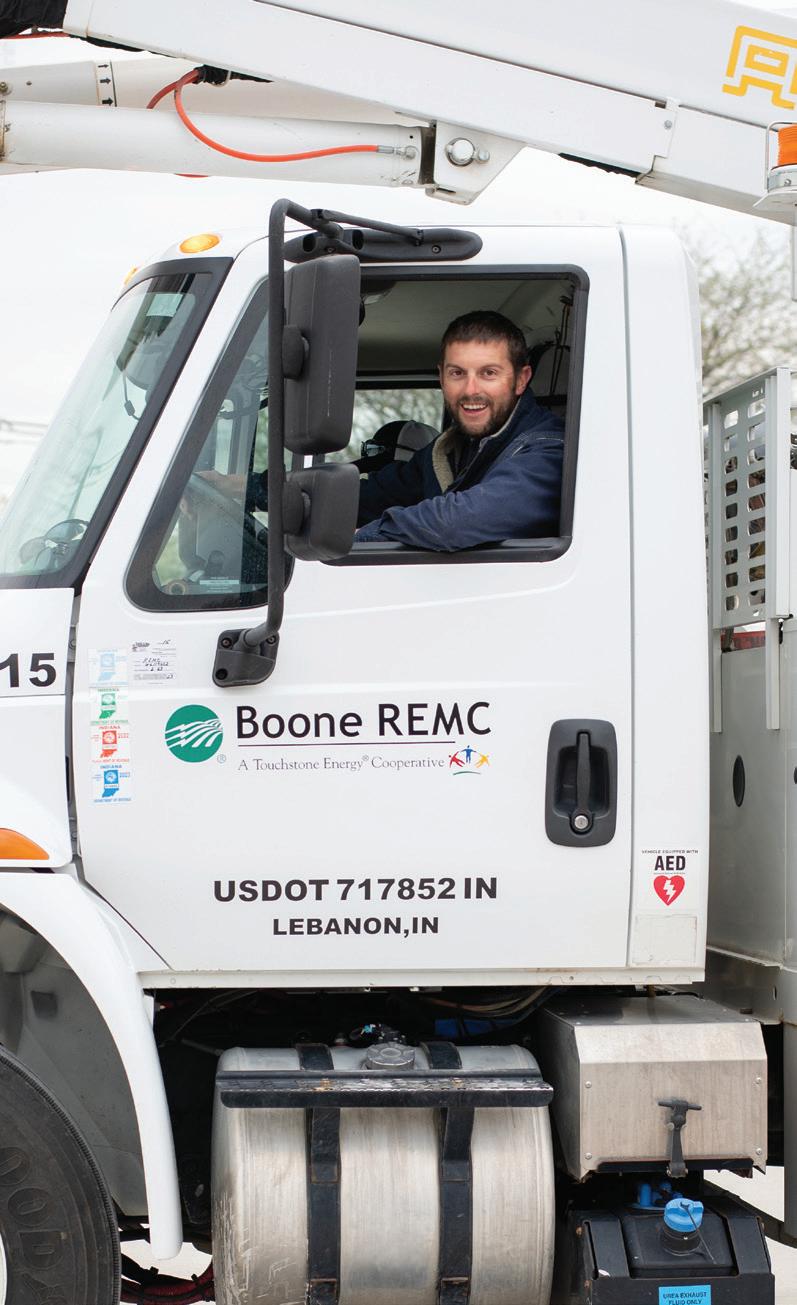
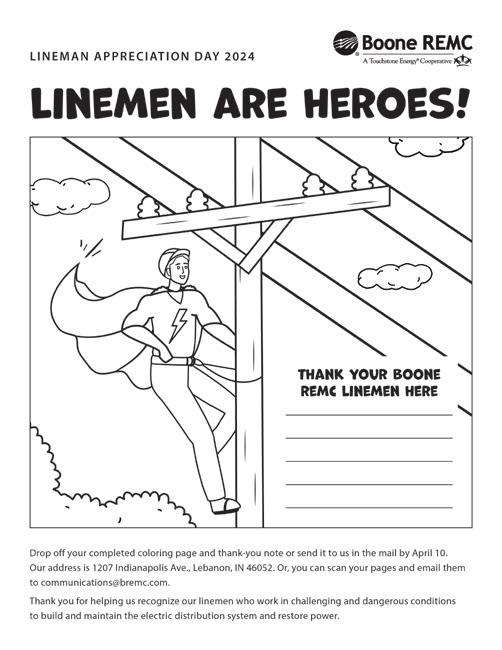
Boone REMC will award 15 - $500 post-secondary scholarships through a random drawing at our annual meeting on April 20.
Applicants must meet the following requirements:
• Be a dependent or legal ward of a Boone REMC member.
• Be enrolled full-time in a post-secondary educational institution during the 2024-2025 academic year. Proof of enrollment will be required by Nov. 1.
• Not be a winner of a previous annual meeting scholarship drawing.
The application must be completed online by 4:30 p.m. on April 19. Visit bremc.com/youth for more details.
Questions can be sent to Mandy Saucerman, Communications Director, at msaucerman@bremc.com. Applicants do not need to be present to win.
Most homes have multiple devices with filters that, if neglected, can negatively impact energy efficiency, comfort, and equipment performance. Proper filter maintenance can reduce your energy bills and repair expenses and make your home more comfortable. Here are some filters around your house that may need your attention.
Your HVAC filter is responsible for trapping dust, pollen, and other airborne particles and keeping them from circulating throughout your home. A dirty filter can also reduce HVAC system performance and efficiency. Check your HVAC filter monthly and replace it regularly according to the manufacturer's guidelines to ensure proper airflow and indoor air quality.
The lint filter in your dryer should be cleaned after each use to prevent fire hazards and maintain proper airflow. Neglecting to clean the lint filter can reduce the dryer's efficiency as well. Also, inspect and clean the dryer exhaust vent at least once a year.
If your refrigerator has a built-in water dispenser or ice maker, it likely has a water filter that needs checked and replaced regularly. This helps remove impurities and maintain the quality of your drinking water. Many refrigerator models have a built-in filter change indicator light or display. Decreased water flow or a

foul odor or taste could also be signs that your filter needs replaced.
Range hood filters collect grease, smoke, and cooking odors. They should be cleaned or replaced regularly to prevent buildup and ensure optimal ventilation. Most range hood filters can be easily slid or popped out from the underside of the hood. Remember to disconnect the power supply before beginning work. Clean the filter thoroughly and let it dry before reinstalling. Consult your owner's manual for specific cleaning instructions.
Many dehumidifier models come with a filter that removes impurities from the air and helps to keep internal components clean and functioning efficiently. The type of filter depends on the model. Some models have reusable filters that can be washed and reused, while others have disposable filters that must be replaced periodically. Check the owner's manual to see if your unit has a filter and how often it needs to be cleaned or replaced.
Both bagless and bagged vacuum cleaners have filters that need to be cleaned or replaced regularly. These filters trap dust and allergens,
so regular maintenance ensures efficient cleaning and prevents clogging. Your owner's manual should include instructions on how to properly clean or replace the filter in your unit.
If you use an air purifier in your home, the filter is essential to ensure its effectiveness in cleaning the air. Different models have different filter maintenance requirements. Some air purifiers have filters that are washable and replaceable, while many models have filters that must be replaced at regular intervals. Check the manufacturer's instructions on filter maintenance guidelines for your model.
Faucet aerators are small attachments that control the flow of water from faucets. They can become clogged with mineral deposits over time. Regularly checking and cleaning them ensures smooth water flow and conserves water. WaterSense®-certified faucet aerators are independently tested to save water while still providing a comfortable flow.
With these simple maintenance tips, you can keep dirty or neglected filters from straining your household budget.
Spring is a time of hope and renewal, but it can also bring severe weather. Take these steps to keep your home and family safe during spring storms.
Make sure your family is ready to stay safe during a storm or other emergency.
• Sign up for your community's emergency warning system.
• Discuss storm safety with your family and what to do in case of severe weather.
• Prepare an emergency kit. Include water bottles, nonperishable food, blankets, firstaid supplies, flashlights, and a battery-powered radio.
Your house is designed to shelter you from the storm. Take a walk around your property and look for these potential issues.
• Check for loose roof shingles or siding and make necessary repairs.
• Look for any tree branches extending over your house or driveway that could fall during stormy weather. Trim them back if needed.
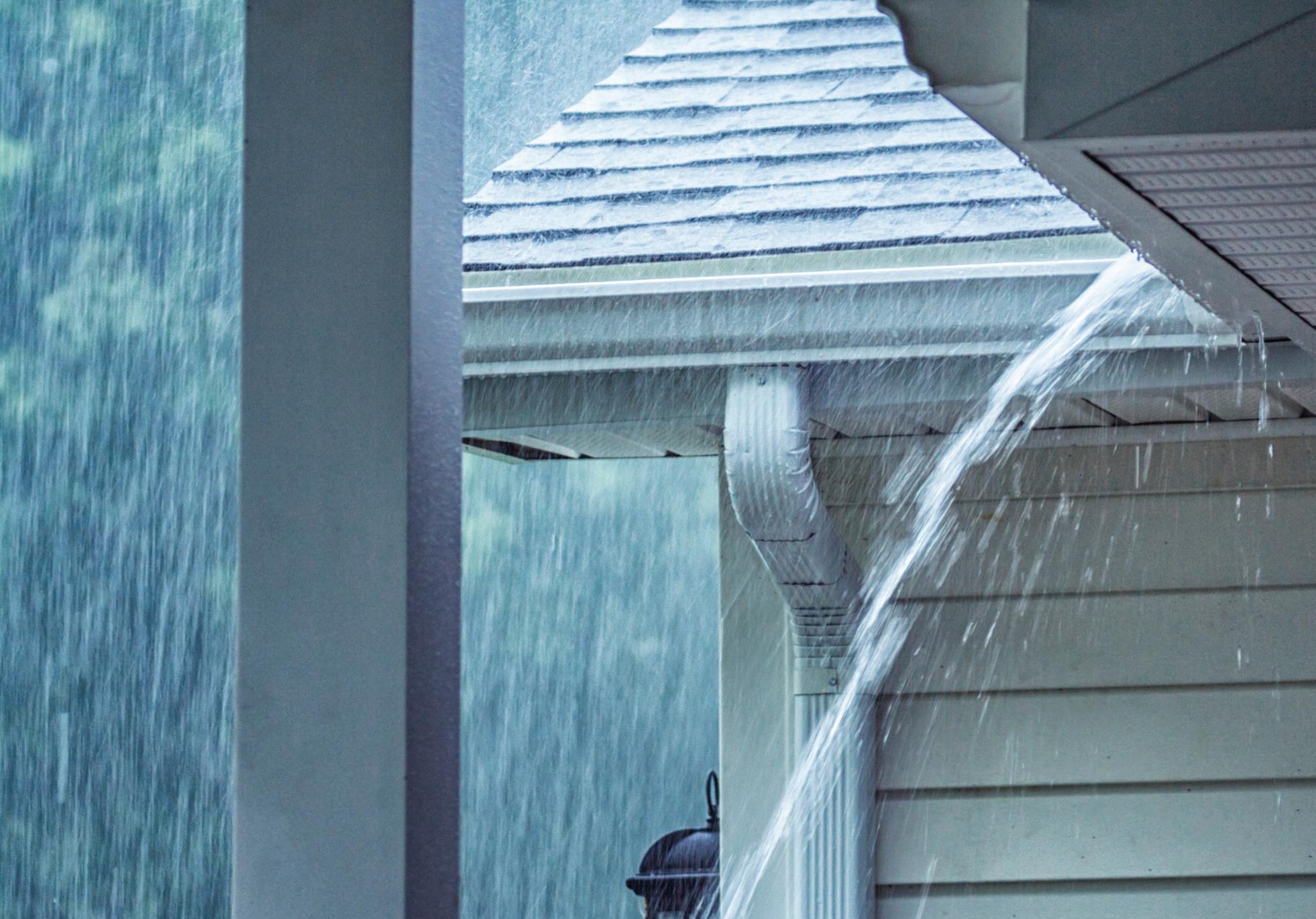
• Inspect unattached structures, like sheds or storage bins, and make sure they are firmly secured.
• Check gutters and downspouts for any debris that may block drainage and clear it away.
• Make sure all gutters are firmly attached and downspouts drain away from the foundation.
• Check the grading around your foundation. A downward slope can allow water to build up during heavy rain and leak into your basement. Repair the grading so that there is an upward slope, allowing rainwater to drain away from your house.
• Make sure fence posts are firmly secured in the ground. Loose fencing can blow over during high winds.
Your sump pump can help keep your basement from flooding in heavy rain. Make sure it's working properly.
• Open up the cover on your sump pump pit and look inside. Clear away any debris that can clog the pump and cause an overflow.
• Make sure the drain hose is connected, and that it's not blocked or frozen.
• Check the inlet screen and make sure it is letting water enter the sump pump pit.
• Lift the water level float up and down to make sure it moves freely.
• Consider a battery backup in case of power outages.
Test the sump pump to make sure it's in working order. Fill the pit with a bucket of water to turn your pump on. Watch it carefully to see if it's getting rid of the water, then check the discharge pipe outside to make sure it drains properly. If the pump doesn't run, make sure it's plugged in and the circuit isn't tripped.
Although we pride ourselves on providing reliable electric service, a storm may lead to an extended power outage. Be prepared. Have candles and flashlights available. If storms are in the forecast, charge your mobile device so you can report your outage to Boone REMC using our SmartHub app and receive updates on the status of power restoration. For backup power, consider purchasing a generator; be sure to read the manufacturer’s guidelines for safe operation.
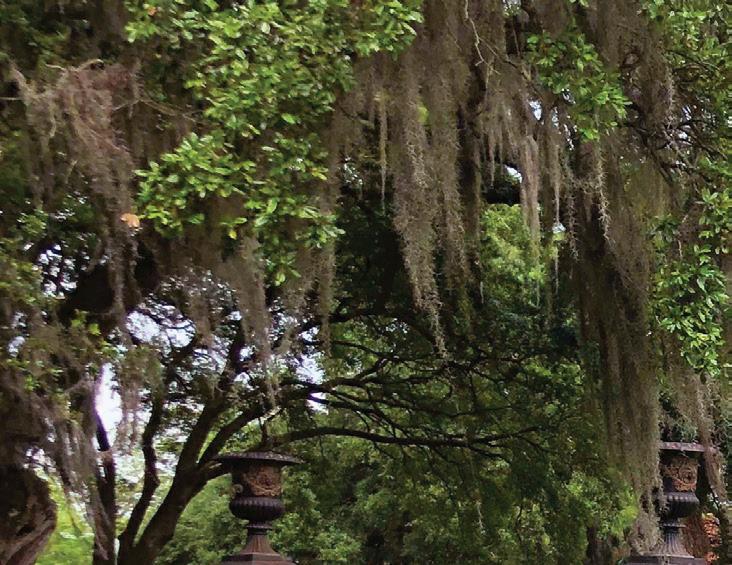

Minneapolis

MINNESOTA
Red Wing Dubuque


Davenport
Fort Madison

Minneapolis
From the French Quarter to the hometown of Mark Twain, experience the best of this legendary river. On an 8 to 23-day journey, explore Civil War history and travel to the epicenter of American music as you cruise in perfect comfort aboard our brand new American Riverboat™.
Small Ship Cruising Done Perfectly ®









Hannibal Alton
Red Wing Winona
MINNESOTA
MISSOURI
IOWA
WISCONSIN
St.
Dubuque
Muscatine
Cape Girardeau


ARKANSAS

ss
LOUISIANA

ILLINOIS
Hannibal Alton
MISSOURI
St. Louis
Memphis

MISSISSIPPI
ARKANSAS
Greenville
TENNESSEE
Memphis Tunica
MISSISSIPPI
Vicksburg
Greenville
Vicksburg
Baton Rouge




Natchez
LOUISIANA

Natchez
Francisville
Baton Rouge
Houmas House

New Orleans
Oak Alley

Alley

Many people grumble in the winter that their windows make frigid frozen air feel at home in their house. Some may think that replacements are the answer to energy savings. Yet it’s important to see the complete picture.
In most circumstances, upgrading windows will not automatically rush in energy cost savings — especially when factoring in the price of new windows. Windows, even the very best, will never prevent as much heat transfer as a well-built wall. The confusion arises because of how heat moves within a house. Heat moves to areas of lesser heat. The natural heat movement in a house gives the impression that the windows are leaking simply because they pull the warmed air their way. Even a triple-pane window doesn’t have the insulation value to stop that movement completely.
Typical windows get about an R-3 rating. The greater the R-value, the greater the power to keep heat where you want it. For comparison, an average insulated wall has an R-11 rating, while an energy-efficient home would have an R-19 to R-40 rating.
Of course, there may be a time when your windows need to be replaced or repaired. Here are some common warning signs:
• Faulty window operation
• Excessive condensation between windowpanes
• Decay and water damage on window frames
• Severe storm damage
Before considering a major upgrade, there are steps you can take that can help improve your home’s windows.
Hang heavy curtains over the windows and shut them when the sun isn’t shining. Closing curtains will help minimize air and heat loss. Be sure to open curtains during the day to take advantage of sunlight.
If air leaks around the window edges, seal it with caulk or nonexpanding foam. Gaps can lead to significant air loss. Be sure to seal around the window to prevent your treated air from escaping.
Consider adding storm windows to single-pane windows. The Department of Energy reports that adding properly rated low emissivity (low-e) storm windows can produce energy savings comparable to adding double-pane windows, but at about one-third of the total cost. Research your options to ensure the best match for your home.
You can contact your local electric co-op’s energy advisor for more information about windows and your home’s energy use. Get a clear idea about how to improve your home’s comfort.
 by Jake Eslinger Energy Advisor
Parke County REMC
by Jake Eslinger Energy Advisor
Parke County REMC
How can
hearing aid that ts inside your ear and costs only $297
a pair be every bit as good as those that sell for $4,800 or more?












The answer: Although tremendous strides have been made



those cost reductions have not been passed on to you. Until now... uses


same kind of technology incorporated into hearing aids that cost thousands



At






At














Covering 236 square miles, Vanderburgh County is southwestern Indiana’s smallest county. Besides the city of Evansville, Vanderburgh County’s other incorporated municipality is Darmstadt, a small German-heritage town. Darmstadt’s 111-year-old International World War Peace Tree was brought over from Germany as a seedling in 1912. The linden tree was planted in 1918 on Darmstadt’s southwestern edge to honor the 1918 armistice, where Germany and the Allied Powers agreed to end fighting in World War I.

One of the best-preserved Native American sites in North America is the Angel Mounds State Historic Site in Evansville. The native town was built between 1000 and 1450 and served as a religious, political, and trade center for more than 1,000 people belonging to Mississippian culture. After excavators uncovered more than 2.5 million Mississippian artifacts, Angel Mounds was designated one of Indiana’s 44 National Historic Landmarks in 1964. Now, visitors can view 12 Mississippian earthen platform mounds along Angel Mounds’ hiking and biking trails.

Home of the Evansville Otters baseball team, Bosse Field was built in 1915 and is the third-oldest ballpark used for professional baseball. Only Boston’s Fenway Park and Chicago’s Wrigley Field are older. Six Baseball Hall of Famers — Chuck Klein, Hank Greenberg, Warren Spahn, Bob Ueker, Bert Blyleven, and Jack Morris — played for Evansville teams during their minor league careers at Bosse Field. Actor Tom Hanks and actresses Geena Davis and Lori Petty filmed the World Series championship game of their 1992 sports comedy movie “A League of Their Own” at Bosse Field.
The 1920s Broadway star Marilyn Miller was born in Evansville in 1898. At 4 years old, she joined her mother, stepfather, and older sisters in their family act, “The Five Columbians,” touring the Midwest and Europe. In 1914, producer Lee Shubert discovered Miller at a London club and brought her talents to New York. Miller became known as a tap dancer, singer, and actress when she played the titular role in the 1920s musical comedy “Sally,” which ran at the New Amsterdam Theatre for 570 performances — one of the longest performance runs on Broadway at the time. “Look for the Silver Lining” was a biographical musical film about Miller released in 1949.

FOUNDED: 1818
NAMED FOR: Henry Vanderburgh, a Revolutionary War veteran and judge for the Indiana Territory
POPULATION: 179,744
COUNTY SEAT: Evansville
INDIANA COUNTY NUMBER:
82
Nicole Thomas is a freelance writer from Indianapolis.

The deadline for submissions for the 2025 Cooperative Calendar of Student Art contest is fast approaching. Entries for the contest should be mailed to the Indiana Connection office by March 29
Entries for the Cooperative Calendar of Student Art Contest are due to Indiana Connection by Friday, March 29
A first-place winner will be selected for each grade, K-12, and will receive $200. The winning artwork will illustrate the cover and the 12 months inside. One “Artist of the Year” will be selected from the first-place winners and will win an extra $100. Additional artists from each grade will be selected for honorable mention awards and will receive $75 and have their works printed in a special section of the calendar.

The contest is open to Indiana public, private, or home-schooled kindergarten through 12th-grade students during the 2023-24 school year. A complete set of rules and required entry forms are available at indianaconnection.org/for-youth/art-contest.

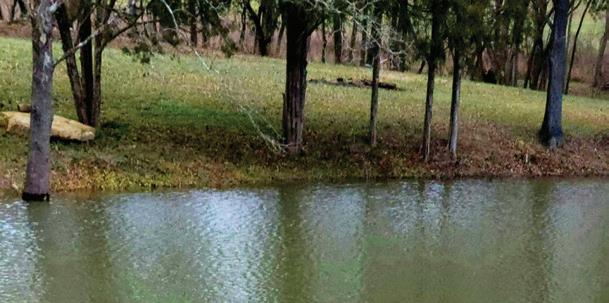

Catch a glimpse of the total solar eclipse or pick up a new pastime while exploring Indiana’s observatories

The zone of totality slices through the Hoosier state on April 8. Get a front-row seat with a visit to one of Indiana’s observatories open to the public.
Indianapolis
A central Indiana standby for over 60 years, Butler University’s Holcomb Observatory and Planetarium is one of the largest public observatories in the world. Stop by for a weekend visit or attend the Eclipse Viewing Festival on April 8 from 12 p.m. to 4:30 p.m. Festival goers can access telescopes outfitted with solar filters for safe observation, chat with scientific experts, and enjoy demonstrations. For more information, visit butler.edu/arts-sciences/ holcomb-observatory
Bloomington
Built in 1900, the Kirkwood Observatory houses a solar telescope, offering otherwise impossible views of sunspots and solar flares. Open monthly for public viewing, undergraduate students host guests on Wednesday evenings during the school year. Enjoy a live-stream view of the sun from Kirkwood’s solar telescope on Eclipse Day. Visit astro.indiana.edu to learn more.
Greencastle
Listed on the National Register of Historic Places, DePauw University’s McKim Observatory still uses many of its original instruments, dating back to the late 1800s. Primarily used by students, McKim welcomes guests during scheduled open houses and for group tours. Visit depauw.edu for open house dates and details.


Terre Haute
This multipurpose observatory, located on the Rose-Hulman Institute of Technology campus, welcomes the astronomically curious to explore the night sky during its regular open houses. If an in-person visit isn’t feasible, view the live webcam from the observatory at 137.112.95.19 using the credentials "public" and password "Observatory."
Natalie Derrickson is a freelance writer from Indianapolis.































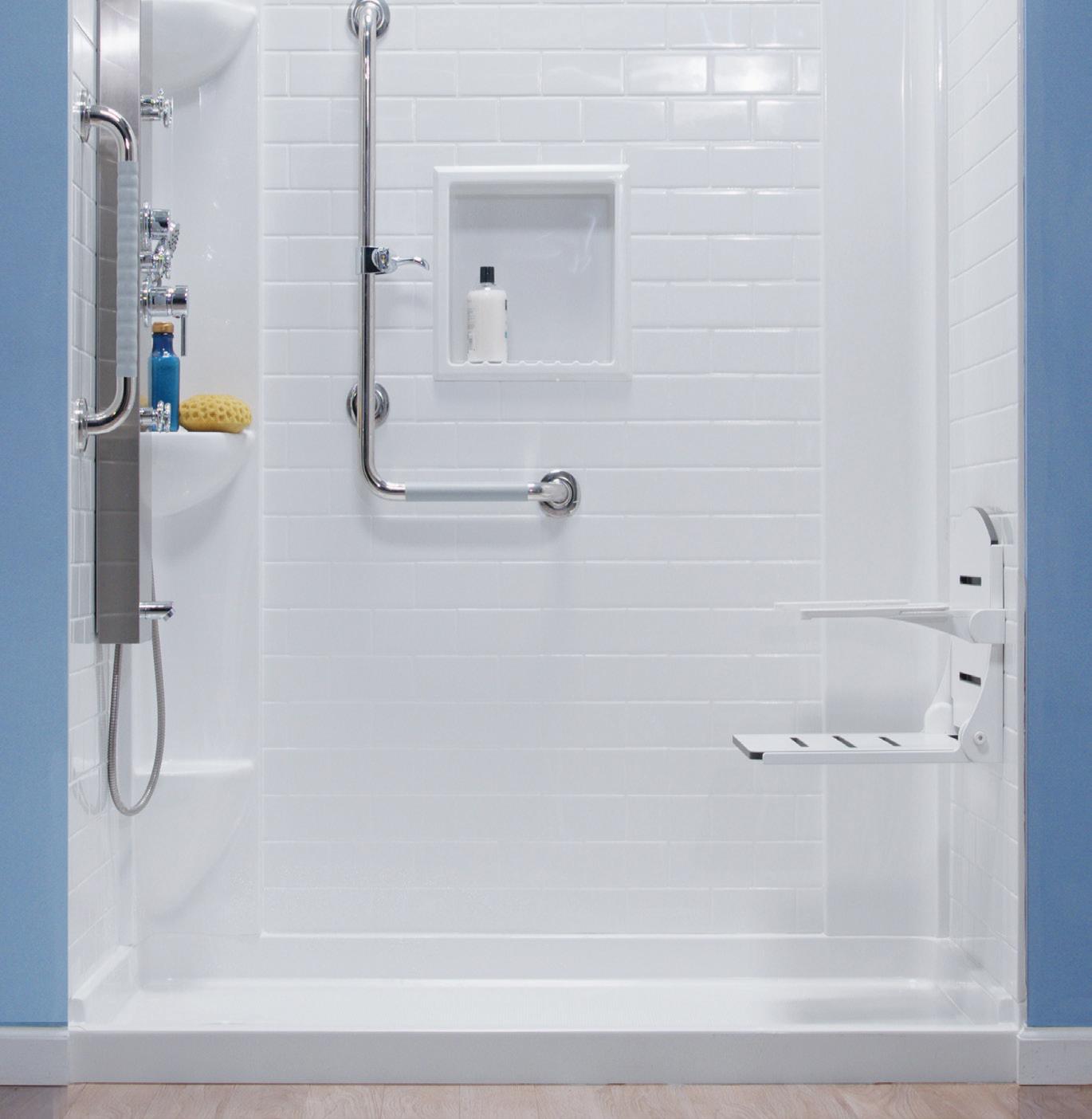


It’s planting season for many of Indiana’s roughly 94,000 farmers. While you prepare to plant the crops that keep the world fed, Indiana Electric Cooperatives reminds you to keep electrical safety in mind.
According to the U.S. Department of Labor Occupational Safety and Health Administration, 62 farm workers are electrocuted each year in the U.S. “Farm worker deaths and injuries can be prevented by practicing some simple electrical safety measures around farm,” said Jon Elkins, vice president of safety, training and compliance at Indiana Electric Cooperatives.
• Make sure farm equipment like planter arms and sprayers safely clear overhead power lines. Tall equipment can easily become entangled in power lines and pose an electrocution risk. Keep a minimum of 10-foot distance from power lines in all directions.
• Consider asking your electric cooperative to move overhead lines around buildings or frequently used pathways. If you’re planning any new construction, consult your cooperative for information on minimum clearances and the location of overhead lines.
• Keep a safe distance from power poles and guy wires when working the land or planting crops. If your
equipment strikes and damages a guy wire or power pole, do not try to fix it yourself. Call your electric cooperative immediately.
• If your farm equipment becomes entangled with power lines, call 911, keep others away and stay calm. If you must exit the equipment for life-threatening reasons, exit by jumping away, landing with feet together, then shuffle three tractor lengths away with feet together. Never re-enter or touch equipment in contact with a power line. Avoid touching anyone who had electrical contact.
• If you are planning a controlled burn, mow and remove vegetation at least 15 feet around any pole prior to burning. Apply fire retardant to the area as recommended by the manufacturer prior to burn period. Do not directly spray or treat a pole. Should a burn get out of control and endanger poles or other equipment, call 911 immediately.
• Prevent fires from passing under power lines, as smoke contains carbon particles that conduct electricity. High smoke concentration near lines can cause an electrical discharge from the line to the ground, posing risks to firefighters. When using water hoses near power lines, extreme care must be taken to avoid contact, as water conducts electricity, turning the stream into a conductor.
SOURCES: U.S. Department of Labor Occupational Safety and Health Administration, Iowa State University Extension and Outreach, National Agricultural Statistics Service, Virginia Cooperative Extension, U.S. Department of Agriculture, Evergy, Kansas State University

WHETHER YOU WANT TO MAKE SOMETHING FROM SCRATCH OR AN EASYTO-PUT-TOGETHER DESSERT IS MORE YOUR SPEED, THESE MOONPIE RECIPES WILL GET YOU IN THE MOOD FOR THE HISTORIC SOLAR ECLIPSE ON APRIL 8.
8 banana MoonPies (Use single or double decker MoonPies. Avoid the mini versions.)
16 oz. whipped topping (one tub)
5 oz. vanilla pudding (cook and serve)
5 bananas
12 oz. caramel syrup (1 bottle)
1. Cut seven MoonPies into four strips. Place the strips, cut side up, in the bottom of a 9x13 baking dish or cake pan.
2. Prepare pudding according to package directions and pour it over the Moon Pies while still warm. Cover dish with foil and refrigerate until cold.
3. Top the Moon Pies with a generous drizzling of caramel sauce. Slice bananas on top, spread whipped topping over these, and then finish with another generous drizzling of caramel.
4. Chop up the remaining MoonPie into bite-sized pieces and scatter pieces on top. Cover again and refrigerate until ready to serve. You can serve it immediately, but it gets better after an hour in the fridge.
Editor’s Note: If chocolate MoonPies are your preferred flavor, you can skip the bananas and use chocolate syrup instead of caramel.

FOR THE COOKIE DOUGH:
6 oz. unsalted butter
¼ cup light brown sugar firmly packed
¼ cup cane syrup
¼ tsp. vanilla extract
1½ cups all-purpose flour
1¼ cups (about one sleeve) graham cracker crumbs, ground fine
¾ tsp. kosher salt
½ tsp. baking powder
½ tsp. baking soda
¼ tsp. ground cinnamon
2 Tbsp. whole milk
FOR THE MARSHMALLOW CENTER:
1 12-oz. container marshmallow crème
FOR THE CHOCOLATE COATING:
1-16 oz. bag bittersweet chocolate
2 Tbsp. vegetable oil or canola oil

1. In a medium mixing bowl, cream butter, brown sugar, syrup, and vanilla until mixture is fluffy, about 1 minute.
2. In a separate bowl, combine flour, graham cracker crumbs, kosher salt, baking powder, baking soda, and ground cinnamon.
3. With the mixer on low, gradually add the dry ingredients to the wet ingredients until the dry ingredients are thoroughly incorporated. In a slow, steady stream, add the milk. Continue to mix until the dough comes together and leaves the side of the bowl.
4. Turn the dough out onto a large sheet of plastic wrap. Flatten with the palm of your hand. Wrap the edges of the plastic wrap around the dough. Refrigerate for up to 1 hour.
5. Preheat oven to 325 F.
6. Turn chilled dough out onto a lightly floured work surface. You may need to let the dough sit at room temperature for 5-10 minutes to make it easier to work with. Roll the dough until it is ¼-inch thick. Cut out cookies using a 3-inch round cookie cutter. Place cookies on a prepared cookie sheet.
7. Bake cookies for 10-12 minutes. They will still be soft when you remove them from the oven. Allow cookies to cool for 10-15 minutes until you can carefully transfer them to a cooling rack. Allow cookies to cool completely before beginning the next step.
8. Once your cookies have cooled, spoon approximately ¼ cup of marshmallow crème into the center of 12 cookies. Top the marshmallow with a second cookie, then gently press down until the marshmallow just touches the edge. Place sandwiches on a cookie sheet and chill for at least 15 minutes.
9. In the meantime, melt the chocolate in a double boiler or in a heatproof bowl set over a small pan of boiling water. Once the chocolate has melted, remove the pan from the heat and allow the chocolate to cool until it is still warm to the touch, but no longer hot. Slowly whisk in the oil.
10. Using two forks, gently place once sandwich cookie into the warm chocolate. Turn until thoroughly coated. Then remove cookies to a parchment paper lined cookie sheet. Let cookies stand until the chocolate shell has completely hardened.

Last October, Tim and Heather Jarboe booked a campsite at Spring Mill State Park. The dates, April 5-9, are not primo times for catching even blooming redbuds and dogwoods in Indiana. But the couple from Athens, Georgia, is coming for a different display of nature. They reserved their front-row seat to the “Great North American Eclipse.”
The total solar eclipse April 8 will be viewable across more than half of Indiana, weather permitting. Its narrow “zone of totality” is centered on a line running northeast through Indiana from Vincennes to Union City. The zone extends about 50 miles to either side. Totality arrives just after 3 p.m. Eastern Time. Totality, when the moon covers the entire sun and the sky darkens like nightfall, will last around 4 minutes in the center of the zone and lessen the farther to the fringe of the zone.
The Jarboes’ trip was kindled by Tim’s first rendezvous with a total eclipse in 2017, the last one to cross the United States. Its path of totality, which went just south of Indiana, passed through northern Georgia. He took off work to see it; Heather, a school counselor in Athens, was needed as students viewed the partial eclipse and couldn’t join him.
“That was an experience that made me want to come to Indiana for this one,” Tim said. “It’s so amazing when the lights totally go out like that. The frogs start bellowing. Bats are flying. All the nighttime mob gets active because they don’t understand. We wanted to make sure we both saw it this time.”
The two will not be alone in their pilgrimage to the zone. The rare celestial event will bring an influx estimated to be between several hundred thousand to as many as a million people to Indiana alone.
Everywhere along the path, from the west coast of Mexico to Texas to Indiana to Maine to the Canadian Maritimes, communities will be leaping and hopping on this moon shadow. Gatherings and festivals have been in the planning stages for a year or more. Music, food, and programs with special guests and speakers will all be part of a holidaylike celebration surrounding the brief but awe-inspiring show.
Vincennes will be among the first of Indiana’s cities to fall under the umbra, the moon’s darkest shadow, and is smack dab on the center line of that sweet zone of totality. Because of that, Vincennes will experience the longest totality in the state at 4 minutes and 5 seconds.
“The path goes right over the Lincoln Bridge that crosses the Wabash River,” said Sarah Wolfe, director of eclipse activities for Vincennes and Knox County. “It’s amazing. It’s like the universe handed us this little prize.”
Tim and Heather Jarboe are coming from Athens, Georgia, in their RV to view the April 8 total solar eclipse near to where he grew up.

“This cosmic alignment is unique,” noted Dan McGlaun, an “umbraphile” and eclipse aficionado from rural Hendricks County. He’s traveled the world to see 15 total eclipses since seeing his first one in 1991. “People should make sure they experience this because they will remember it. Little kids should write down their experience and put it in a time capsule. Then, 50 years from now, when they watch another eclipse with their grandkids, they can pull that out and remember.”
A total solar eclipse occurs when the moon passes between the sun and Earth, blocking the sun’s light and shadowing part of our planet. It happens about once every 18 months. The narrow band of totality is usually around 9,000 miles long but only about 100 miles wide. So, while a total solar eclipse may occur every couple of years, a single given spot experiences totality just about once every 375 years.
Though this is the second total eclipse in seven years to have arched across the U.S. and garnered massive media attention, folks shouldn’t get used to them. After
April 8, the next solar eclipse over the contiguous United States won’t be until 2044, and it will only be over parts of North Dakota and Montana.
Meanwhile, this will be the first total eclipse visible anywhere in Indiana since Aug. 7, 1869. Indiana’s next time in the spotlight of totality, or deepest shadow, won’t be until Sept. 14, 2099.
For Earthlings to even experience the sublime perfection of a total eclipse is a cosmic coincidence — or, maybe, a wink and a nod from God. Consider the odds: The sun’s diameter is about 400 times larger than Earth’s moon, and the sun just happens to be about 400 times farther away from Earth than the moon. That makes the sun and moon appear to be the same size in our sky. When they align, it’s so precise that the moon blocks all the sun’s direct rays for just a few fleeting minutes. Yet, the moon’s still small enough to let us see the sun’s corona, that rarefied gaseous, ghostly glow we would never see otherwise.
Since the 2017 eclipse, McGlaun has parlayed his vast expertise gained over the years by chasing eclipses around the world and learning from
continued on page 22
Seeing a total eclipse can be a profound once-in-a-lifetime event. But make sure it’s not the last thing you ever see by following these viewing tips.
• When watching the partial phases of the solar eclipse with your eyes, you must always look through safe solar viewing glasses (“eclipse glasses”) or a safe handheld solar viewer. No matter how dark, sunglasses are not safe. Safe solar viewers must comply with the ISO 12312-2 international standard.
• Always inspect your eclipse glasses before use; discard the device if torn, scratched, or otherwise damaged. Always supervise children using solar viewers.
• If you usually wear eyeglasses, put your eclipse glasses on over them.
• When the moon completely blocks the sun during totality, it is safe to look directly at the eclipse without specialized eye protection. If you watch the eclipse with viewing glasses, it’s safe to remove them when the sun totally disappears. You must put them back on the first instant the sun reappears after totality.
• If you don’t have eclipse glasses, turn to the below websites for tips on indirect viewing methods.
• Do not use eclipse glasses or handheld viewers with cameras, binoculars, or telescopes. Those optical devices require a different kind of solar filter made for their concentrated magnification.
• Avoid ordering eclipse glasses from Amazon or other online marketplaces not listed as an endorsed vendor by the American Astronomical Society. Fake eclipse viewers sold online may claim to be ISO certified but are not, which can be dangerous for your eyes.
Please visit these websites:
• eclipse.aas.org
• eclipse.iu.edu
• eclipse.gsfc.nasa.gov/eclipse.html
• eclipse2024.org
• in.gov/dnr/places-to-go/events/ 2024-solar-eclipse
• purdue.edu/home/total-solar-eclipse/
• visitindiana.com/eclipse2024
continued from page 21
other experts into a full-time job. A Purdue-trained mathematician and computer scientist, he’s been a technical projects manager, school teacher, and private tutor. His Eclipse2017.org web page received a web-crashing 10 million hits a day leading up to that eclipse. His updated Eclipse2024.org site continues as a veritable smorgasbord of everything anyone would ever want or need to know about the eclipse and how to view it safely.
A unique feature on his site is a simulator, created from his own computations, that will accurately depict how the eclipse will appear in the sky from first contact, partial stages, totality, and then the passing out of partial for 140,000 locations along the path of totality. The entire eclipse sequence is animated in either real-time or can be sped up.
Though McGlaun is speaking at a big eclipse event in Texas on April 7, he’s planning to fly home to experience this one from his own yard with family and friends. For months and years, he’s been enthusiastically traveling around Indiana and elsewhere talking about this day and what it means.
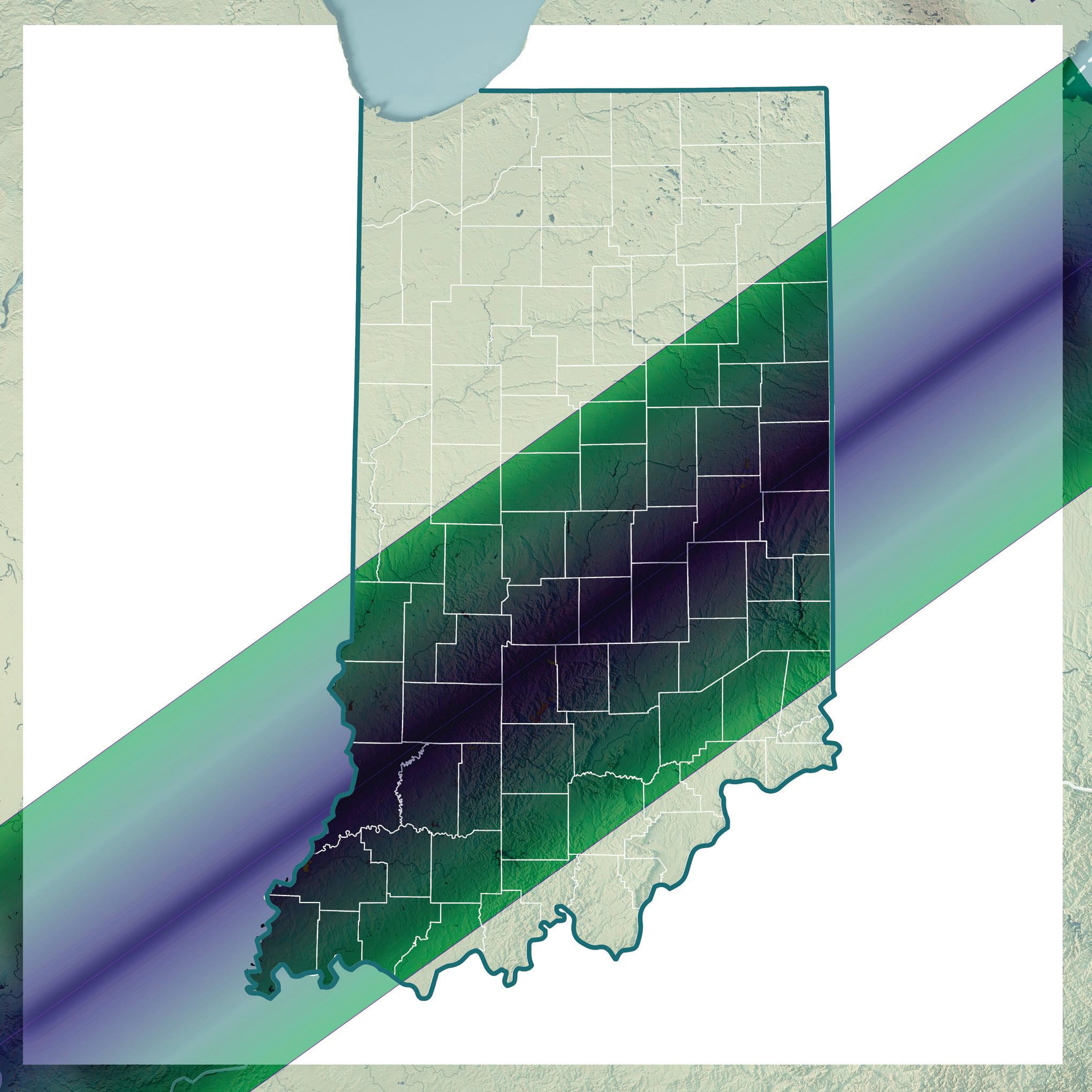
One of his main messages is: Get to the zone of totality. Even though the moon will cover 90% or more of the sun’s surface in those areas of Indiana outside the zone of totality, even a crescent of sunlight makes a night-and-day difference in the overall experience.
McGlaun’s given over 100 presentations to schools, civic groups, planning and tourism commissions, and the like, encouraging folks not just to witness this one but also to welcome visitors and celebrate this special event. “You’re sharing something really amazing with so many other people,” he said.
“There is a tremendous amount of buzz surrounding the total solar
SOLAR ECLIPSE
APRIL 8, 2024
100% Coverage*
2-----3-----4

* approximate duration in minutes
Union City
Indianapolis
Bloomington
Spring Mill State Park
Vincennes
and communications for the Indiana Destination Development Corporation, the state tourism office. She said the office is working with local, state, and federal officials to make sure communities and businesses will be able to meet the needs of the crowds the eclipse is expected to bring. “We are currently finalizing a checklist with the Indiana Department of Homeland Security,” she said. “IDHS is on it, and talking trash, traffic, toilets, and so much more.”
Along the path, communities will be hosting special events with music, and food and highlighting what makes each special. Some events in wellknown outdoor venues include:
Purdue University for an eclipse viewing event at the famed track. NASA will broadcast live, with experts sharing insights.
• Multiple Boone County locations are encouraging folks to “Get Mooned in Boone” with a wide range of familyfriendly events.
• The University of Southern Indiana in Evansville is hosting Solarpalooza, a multi-day event that will include a retired NASA astronaut, a full day of experiential learning, and more.
• Indiana University in Bloomington is opening its football stadium as a gathering location. Even “Star Trek” star William Shatner, Capt. James T. Kirk, himself, will be beaming himself down, as part of the star-studded
celebration. Mae Jemison, the first African American female astronaut will also be a guest. Like most schools in the zone, IU has canceled all in-person classes April 8.
In addition, the IU Center for Rural Engagement awarded 30 rural organizations across 22 counties micro-grants of up to $2,000 to host arts, education, and cultural activities connected with the eclipse. The funding was provided through the Simons Foundation, a New York City-based organization advancing research in mathematics and basic sciences.
While gazing to the heavens may seem contrary to bringing people closer, Wolfe, at Vincennes and Knox County, noted that notion is what attracted her to the role as the eclipse activities planner a year ago.
“Professionally, I’m an artist,” she said. “When I heard about this job, there were many aspects that I found fascinating. I love the community engagement and the opportunities that the eclipse offers. I love data and logistics,” she said. “But more than anything, I truly feel that this eclipse is an opportunity for all of us to reconnect to our humanity and heal divisions that we’ve experienced. We’ve been forced apart so many times over the last four years. Here, we’ve got an opportunity to enjoy an awe-inspiring celestial event we get to experience together.”
The most common question McGlaun is asked concerns the weather. While a total solar eclipse can be plotted to the day, hour, and location for centuries, the weather forecast for the next is not as predictable. On average, April 8 in Indiana is often cloudy. But April 8, 2023, provided “glorious” weather.
“Your eclipse day is going to be what it is,” McGlaun said. “If you are around people who are special to you in a place that is special to you, that is your story.”
He said getting to another location is much easier if you start in a rural spot away from traffic jams that are expected in congested areas. “But that’s part of your experience. It’s part of what happens. Sometimes you can do something about it, and sometimes you can’t. It is a true and God-honest metaphor for life: You get the hand you’re dealt, and you play.”
For the Jarboes, Spring Mill fits McGlaun’s criteria. The now-retired couple met at Indiana University. He was from Tell City; she was from North Carolina. Their extended trip north will also include visiting his family in Perry County, just south of the zone of totality, and old college friends near Indianapolis and in Ohio.
“I can remember going to Spring Mill with my family when I was little,” said Tim, who earned his teaching degree from IU and taught elementary school in Bloomington after graduation.
“One of the first field trips I ever took students on was to Spring Mill State Park,” he added. “So, it’s cool to go up there for the eclipse to the park where I started my career.” Soon after he and Heather married in 1985, they moved to Georgia where they established long careers in education.
For the Jarboes, visiting family and friends will mean a cloudy day on April 8 won’t make the trip all for naught. Plus, Tim is looking to even the bright side of a cloudy eclipse day. “Even if it’s cloudy, it’ll still get dark. That’s one of the neat things about being in the zone of totality,” he said. “Now, we might not see the corona of the sun, but we’ll experience the environment when suddenly every living thing says, ‘It’s time to wake up and start doing nocturnal things.’ You’re still going to have some of that experience. It’ll be an incredible event to be part of no matter what.”
“We wouldn’t miss it,” Heather quipped, “for the moon and the stars.”
Richard G. Biever is senior editor of Indiana Connection.
Dan McGlaun has traveled the world to witness 15 total solar eclipses in the past 33 years. Only one attempt, in China, was “monsooned out.” Visit his website, Eclipse2024.org, to prepare for how to view the eclipse safely, what you will see, and when. Here, McGlaun offers two final fine points to keep in mind.
THE WEATHER: Sadly, the long-anticipated day can be spoiled by the weather. McGlaun suggests that if it’s overcast and raining, have a Plan B. Try to get as far out from under the weather while staying within the zone of totality. He said that’s why Indianapolis is a great place to plan to see it. Indy is a hub intersecting Interstates 65, 69, 70, and 74, plus it has multilane U.S. and state highways also spoking out in all directions.
If the weather is “iffy,” with puffy cumulus clouds, he said keep an eye out as the time of totality approaches. During 2017’s eclipse, he decided to bug out at the last minute as one huge cloud approached.
“We ran five or six miles south to outrun that cloud and made it just in time for totality to start. If you need to relocate, there are plenty of places and ways to do it. Just make sure you do it safely. Don’t stop on the side of the road, in the middle, or anything like that.”
EYES ON THE PRIZE: Many things will happen in the few fleeting minutes of totality, which will arrive just after 3 p.m. Eastern Time. McGlaun said folks will be tempted to shoot photos and video. Unless you are a professional photographer with the proper lenses and gear, he suggests taking it all in with just your eyes and other senses, unencumbered.
“If you see it, you will be changed. It is a wonderful, spiritual, jaw-dropping, and amazingly terrifying experience. It’s something that we’ve been given the gift to see. And we should take advantage of these gifts. You’re going to be fumbling with stuff, and you’re going to miss out on what you’re supposed to be looking at, which is the most amazing thing you have ever seen. There are apps out there now that are designed to capture it, but I can guarantee you that you won’t capture what you’ve experienced. Look up from your phone and look up to the sky.”
Stay in the home and neighborhood you love with a Stiltz Homelift.
The Modern Solution
A Stiltz Homelift is a safe, attractive, & affordable alternative to stairlifts. It requires no special machine room, and no supporting walls.
Economical & Flexible
A Stiltz Homelift can t just about anywhere in your house. It has a compact footprint, similar in size to a small armchair. A Stiltz Homelift plugs into a standard home electrical outlet, using less power than boiling a kettle.
Your Forever Home
Avoid the expense and distress of relocating, or the disruption of adapting your home for downstairs living. A Stiltz Homelift helps you live safely and independently in the home you love.
Some Stiltz customers need a Homelift immediately. But others want to “future-proof” their homes for when the stairs become a challenge.
Homelift Specialists
Stiltz is a world leading Homelift manufacturer, so you’ll be in good hands. Your elevator will be installed and maintained by Stiltz trained professionals - who truly care about your freedom.
“I can’t imagine what we’d do without it. I wish we had installed our Stiltz Homelift several years ago!”
– Mr. James, Roanoke VA










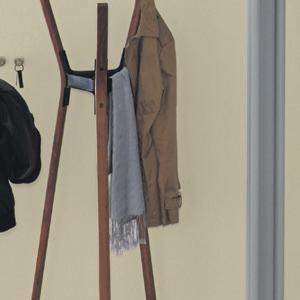











“Don’t look back,” legendary baseball pitcher Satchel Paige used to advise. “Something might be gaining on you.” For most of us, that something is time. But in our headlong rush around life’s bases, a glance over the shoulder is sometimes appropriate. This is mine. This is my final issue as senior editor of Indiana Connection. After 35 years and two months, 422 monthly issues, I will be retired by the time this lands in mailboxes in March. My final day was Feb. 2, Groundhog Day.
I hope I won’t be waking every morning to “I Got You, Babe,” the Sonny and Cher oldie that awakened Bill Murray every day in the movie “Groundhog Day,” as he was stuck reliving the same day, over and over again. But, I do hope to work on improving myself a little each day as Murray’s character ended up doing with his daily do-overs.
Before pressing on to a new chapter, I’ve looked back on the past pages. In my (now old) office are two shelves holding all the bound volumes of this publication. The top row is all the issues from when it began in July 1951 to December 1988. It was originally called Indiana Rural News, then Electric Consumer. The bottom shelf picks up with January 1989, when I arrived, and runs to present as Indiana Connection. Over the past months, I found myself running my fingers across the books on the second shelf. Occasionally, I’ve pulled one out and wistfully thumbed through the pages. Reading stories I’d written when I was half my current age spun me back down the years — the way an old song does when it pops up on the radio. I recall the details and the people of that story — and that time and place in my life, as well. I’ve dog-eared many of these pages and memories in my mind.
The first story I worked on was for the February 1989 issue. I visited the edges of a coal mine in northern Daviess County on a misty, cold, gray January day. An entrepreneur, who was apparently part alchemist, set up a small-scale operation there that removed sulfur from coal using dry-cleaning fluid and old equipment from a chocolate factory he bought at auction. Though it sounded a little far-fetched, his efforts to take it utility scale were backed by groups in the electric and coal industries. Back then, burning high-sulfur coal was linked to acid rain falling on the Northeast U.S. and Canada. If this cleaning process
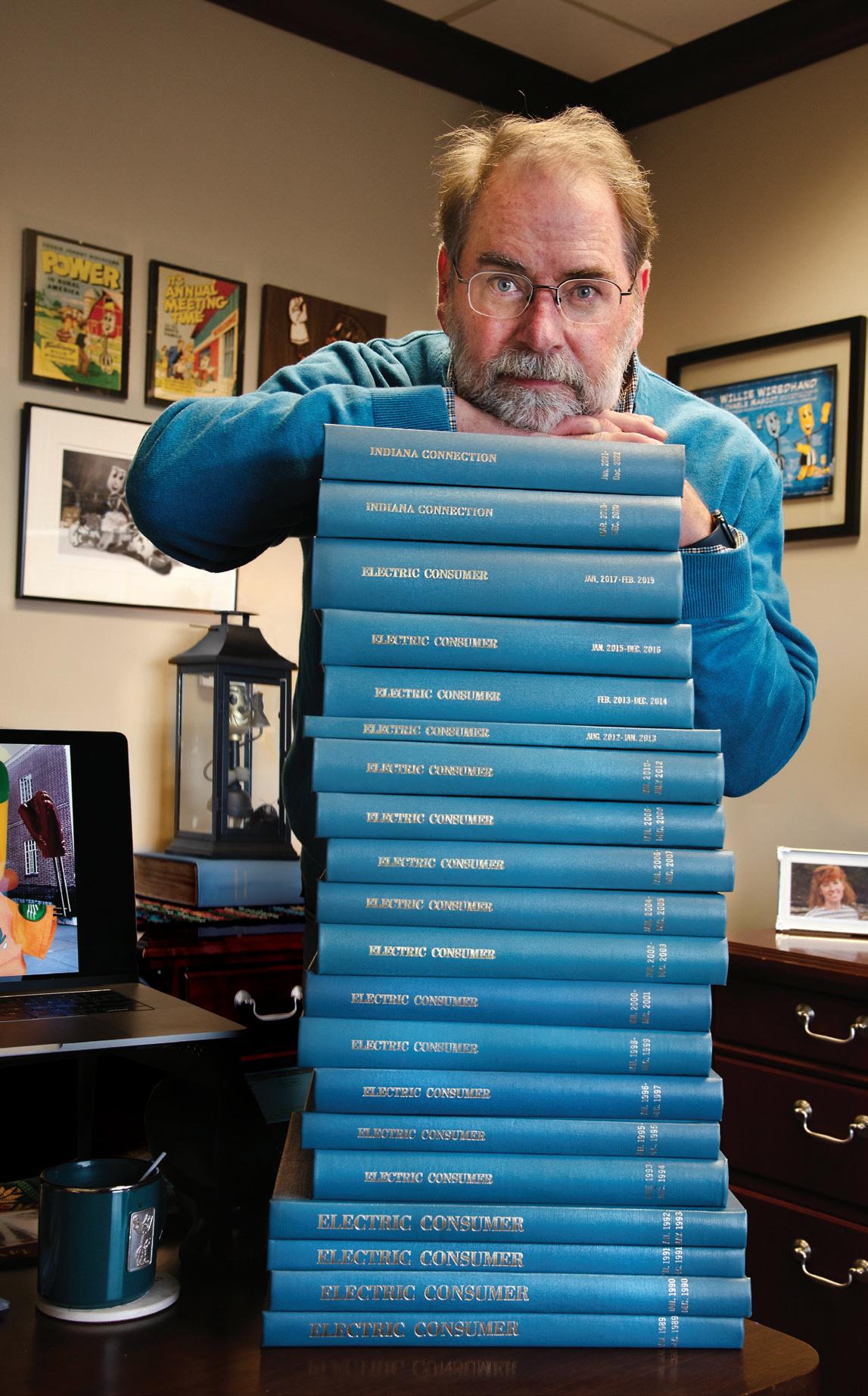
could keep Indiana’s high-sulfur coal viable and reduce acid rain, this was big. For a 27-year-old guy coming from a suburban Indianapolis newspaper — where covering interstate fatalities and murderers for four years had worn me thin — this was fulfilling and fascinating stuff.
Oy, how things changed in 35 years. Acid rain was solved in part by utilities and an act of Congress, but it was a sprinkle compared to global climate change linked to greenhouse gases that has dominated the electric industry since. Over the years, I’ve written about these concerns and the new technologies — wind and solar farms — that are cleaner, albeit less reliable, than fossil fuels. I’ve written about new considerations of nuclear power, development of hydrogen fuel cells and capturing waste gases from landfills and large dairy farms to generate electricity. And I’ve written about the co-op programs promoting energy efficiency and home construction techniques that reduce a home’s carbon footprint, save consumers money and make their homes more comfortable. That’s a feel-good story for everybody.
While energy topics were always important, I’ve written about other rural issues like healthcare, economic opportunities and the devastation caused by the scourge of methamphetamine. But my favorite stories have been the softer features about co-op consumers and Indiana.
I’ve loved writing about Indiana’s connections to: Abraham Lincoln; Gus Grissom; “Old Ironsides” (the U.S.S. Constitution), whose new white oak timbers come from the woods at Crane Naval base; and baseball Hall of Famers Gil Hodges and Hank Aaron. I loved covering the school kids and teacher who successfully lobbied for the firefly as the state insect; and state DNR officials who let me tag along as they banded baby bald eagles and barn owls.
After 35+ years, 422 issues of the monthly publication, it would be impossible to list all my favorite stories, or even a smidgen of them and not leave out dozens. My “favorite story” always felt like the one I was working on at the time. But some of the most memorable stories or projects include:

I’ve loved the stories and photos I’ve gathered: from the Indiana Dunes National Park and the state parks; from the banks of the Wabash and Ohio rivers to the scenic highways and bicycle trails; and from venturing deep into Indiana’s commercial caves, voyaging across the night sky with Indiana’s astronomical societies, and looking at the sun with this month’s cover story.
We often asked readers to write the cover story for us in the form of short recollections. Topics have included holiday traditions and memories, World War II, the JFK assassination, the Beatles at the state fair, 9/11 and the joy of living in rural Indiana. And from 1996-2005, we asked readers to illustrate the December cover story, too, with a Christmas tree ornament contest. It was always my pleasure to edit the written memories, photograph the hand-crafted ornaments and then present those pages. The ornament contest introduced me to Maria Fedyniak, a consumer who created intricate, traditional pysanky eggs she learned to make as a little girl in her native Ukraine. She became a dear friend who patiently tried to teach my wife, Beth, our children and me the skill. And in these pages, I even had a chance to share the personal story of our two children, now both 26 years old, who Beth and I adopted as babies from a Russian orphanage near Ukraine.
One of my favorite scenes from my favorite baseball movie, “The Natural,” has Robert Redford as the mythical Roy Hobbs pondering the probability his playing days are done. He looks up from a hospital bed to the love of his life, played by Glenn Close, and earnestly sighs, “God, I love baseball.” I feel the same way about the career electric co-ops and you all reading this have given me. I’m going to miss being a part of all this. This is going to sound sappy, but it’s sincere, when I say: God, I love co-ops. And I’ve loved sharing these stories and these pages with you.
Mascot Willie Wiredhand has been connecting electric co-ops to consumers since the 1950s. Enthusiastically, I jumped on Willie’s bandwagon when I came aboard. Willie proved he could still endear himself to new generations teaching electrical safety, efficiency and even geography. He’s helped illustrate many of the stories I’ve written over the years. All the friendly folks we know at our local co-op eventually will retire. But Willie’s friendly shining visage will live on.
Spending three weeks with a group of linemen as they constructed the power lines and wired the huts to electrify a a poor village in rural Guatemala in the spring of 2019 was unforgettable. Basking in this “National Geographic” photographer opportunity, I was never more proud of the people and the organization with and for whom I work.


No single story I’ve written affected me as deeply as this one in the summer of 1997. Valerie James was an extraordinary high school senior from Wolcott who was beloved by her peers and their parents around the state for her leadership in FFA and 4-H. She died in a car crash a few weeks before the county fair. My story was going to be how the community planned to support her animals at the fair. But her grieving family invited me in like a friend to share the story of her smile and deep Christian faith. And the story became profoundly more. Though I never met Valerie, thoughts of her touch me to this day.

In 1998, longtime editor Emily Schilling, who retired in 2023, and I shared an idea to turn an informational wall calendar we had been producing for co-ops into a medium to encourage and reward student artists. The calendar would be illustrated with the winning works from a student art contest we held. Given 12 months of a year/12 grades of school, the format seemed natural: each grade was assigned its corresponding month. Kindergartners were assigned the cover. After almost 100,000 entries over 26 years, the art calendar remained one of my favorite projects.
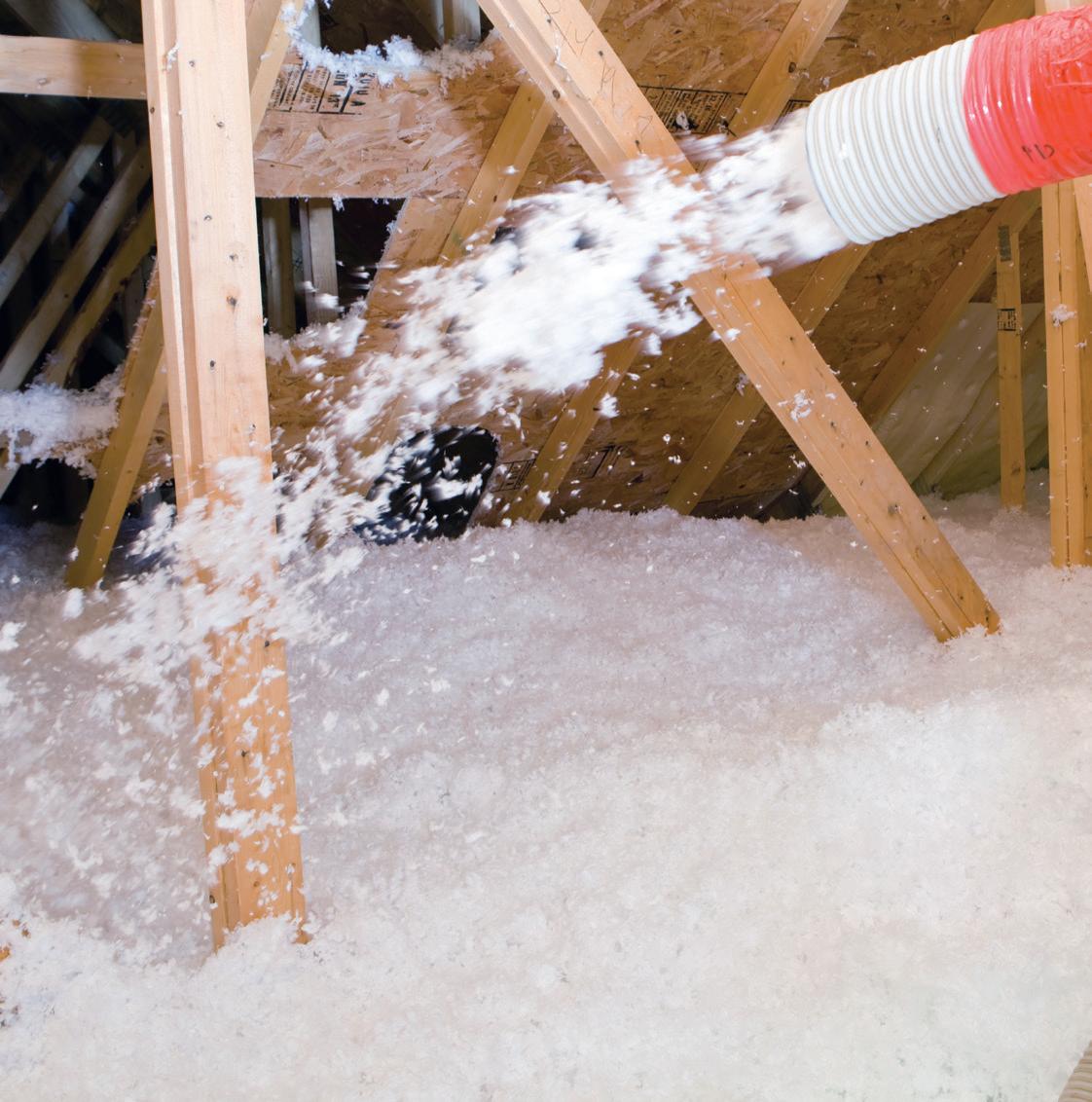
Properly
This time of year, it’s not just basketball madness that people feel. The volatile Indiana weather can feel like all four seasons in one day.
This spring, your home’s temperature may feel like it’s soaring and sinking with the weather. To avoid scary energy bills caused by your heating and cooling system working harder than needed, three words — seal, insulate, and equip — can ensure you’re prepared for weather volatility.
If your home feels chilly, then creepy crawlies may not be the only things hiding in your attic or crawlspace. Air leaks may be causing conditioned air to escape. You should search for and seal any air leaks. The most critical leaks to seal are in your attic and down low in your basement or crawlspace. Framing and places where
plumbing, electrical wiring, or ducts poke through the ceiling must also be checked. Sealing air leaks keeps your warm air inside during the winter and cool air indoors in the summer.
This step should be taken after sealing air leaks. Air leaking through the insulation decreases its benefits. If part of your HVAC ductwork is located in the attic, it is especially important to seal it and bury it in insulation. By adding insulation properly, your HVAC system will have to work less to maintain the temperature in your house, saving you electricity and money.
After you have sealed air leaks and properly insulated your home, you

can check into new equipment. Now that some of your home’s issues are resolved, you may need smaller equipment to heat and cool your home properly. A smaller, right-sized, and more energyefficient system will increase electricity savings, helping your wallet well into the future.
The best way to diagnose issues in your home is to schedule an energy audit. You can contact your local electric cooperative’s energy advisor for details. Your co-op may even be able to provide the audit, which includes recommendations on steps you can take to improve your home’s energy efficiency. You can get an idea of what options — and Power Moves® rebates — are available to keep you comfortable all year long.



When welcoming a new dog, there’s more to consider than meets the paw.
The prospect of a new dog understandably sparks excitement, but don’t let those puppy dog eyes distract you from making a thoughtful decision. Consider these factors before you schedule your meet-andgreet with a potential new pooch.
How you go about your day pre-pup will shift once there’s a dog on duty. Assess your current lifestyle and how your new family member will integrate into your routine.
“The biggest thing to consider when choosing a dog for your family is what type of lifestyle you have,” said Nichole Kanney of HELP the Animals, a no-kill shelter in Richmond, Indiana.
A spunky Labrador Retriever or Australian Shepherd may make your daily run even more fun. An even-tempered Basset Hound, Charles Spaniel, or a mixed-breed senior dog can be a calm and cozy movie buddy.
Your household will influence your pet choice. A patient dog is a must in homes with kids, as the likelihood of a less-than-gentle tail pull or role in a game runs high.
“We always do a meet-and-greet with everyone in the household and other dogs to ensure they will all get along,” said Kanney. “We also offer foster-to-adopt situations where you can try the animal in your home for seven days.”
Facilitate a trial run to assess how you and the dog feel about the arrangement. If you regularly host gatherings or have frequent guests, see how the dog handles new people and busy environments.
There’s no denying that a puppy is cute, but training demands a
new budget line item and time. Teaching a pup your home’s rules for behavior, furniture, and bathroom breaks requires patience.
All breeds need regular veterinary care, but some are prone to health challenges. Research the common health risks of the breeds you are considering to identify their potential long-term needs.
Take grooming into account, too. Short-haired Beagles will be lower-maintenance, while Shitzu’s will need their coats trimmed and shaped regularly for style and function.
No matter what the perfect dog looks like to you, Kanney recommends that new pet parents keep in mind the 3-3-3 rule. “It takes three days for a dog to understand it left the shelter, three weeks for it to settle into your routine, and three months to integrate into your home fully.”

Before planning your spring cleaning or outdoor projects, consider ones you have perhaps been avoiding due to their “yuck” factor. Put on your grubby clothes, and let’s accomplish some messy or smelly but oh-so-satisfying DIY!
If you hate the look of popcorn ceilings, you are not alone. Not just unfashionable, they are also often unsightly and unsanitary. Dust, cobwebs, and years of kitchen or cigarette smoke can make them appear dingy. While not the tidiest process, popcorn removal is straightforward and requires simple tools.
Note: If your home was built before 1979, pick up an asbestos testing kit and test a small sample before starting this project.
Protect yourself from dust and debris with safety goggles and a dust mask or respirator. Secure plastic sheeting with painter’s tape to protect floors and fixtures. A sturdy ladder or scaffolding helps you safely reach a standard or cathedral ceiling. Fill a pump garden sprayer or spray bottle with hot water and soak small sections to moisten and loosen the popcorn. Then use a wide, flat-edged putty knife or drywall knife to easily scrape away the wet material.
Patch any imperfections in the newly bare surface with drywall joint
compound. Smooth them out with a sanding sponge and follow up with a damp sponge. Finally, grab a paint roller, roller covers, and an extension wand. Bare drywall is thirsty, so consider two coats of primer and up to two coats of ceiling paint. Roll up the debris in the sheeting and discard it.
Painted cabinets or furniture can seem dated, so try stripping them. If upcycling is your bag, this multipart (and time-consuming) process is well worth the effort. A heat gun helps soften up old layers of paint or varnish. Or pick up some paintstripping solution, heavy-duty rubber gloves, drop sheets, and a scraping tool when purchasing a new stain finish and applicators.
Next, chat with the experts at your local hardware store, review some online tutorials for extra confidence and give it a go. Set up extra tables or sawhorses in your garage to create

an assembly line and keep fumes out of the house. Finally, it’s a great time to update your pulls, handles, and hinges with a modern finish.
Removing outdated wallpaper can be messy, but it’s easy with the right supplies. First, lay down drop cloths or plastic sheeting to protect your floors. If peeling off paper manually doesn’t cut it, grab a scoring tool to create small perforations in the paper. This allows a steamer or solvent to penetrate it and loosen the adhesive. Don’t be shy with remover solvent, as it may require a generous amount. After some time, use a wallpaper scraper or putty knife to gently remove long strips without damaging the wall underneath. Once all paper is removed, clean the wall with water and a small amount of dish soap. Repair any damage with spackle and sandpaper, then wipe down again before applying a fresh coat or two of paint.
By Brian TaylorBusy dreaming of your spring projects? Contacting 811 is just the beginning.
Digging with care is just as important as contacting 811. The tolerance zone is an area where special care must be taken to dig near a buried utility. Regulations mandate a two-foot tolerance zone on either side of the marks on the ground and all around the utility itself.
If you can’t avoid digging near the paint or flags on the ground indicating a utility is present, it’s critical that you dig carefully with hand tools to avoid damaging the utility.
The size of the tolerance zone is always two feet plus half the width of the utility, so the size will change depending on the utility’s diameter.
The tolerance zone is an added safety feature designed to help you prevent hitting the buried utility!

Have more questions on safe digging? Visit our FAQs page to learn more.
